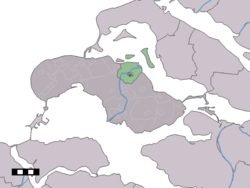Zonnemaire
| Zonnemaire | ||
|---|---|---|
| Village | ||
 | ||
| ||
 | ||
 The village centre (dark green) and the statistical district (light green) of Zonnemaire in the municipality of Schouwen-Duiveland. | ||
| Coordinates: 51°42′45″N 3°57′3″E / 51.71250°N 3.95083°ECoordinates: 51°42′45″N 3°57′3″E / 51.71250°N 3.95083°E | ||
| Country | Netherlands | |
| Province | Zeeland | |
| Municipality | Schouwen-Duiveland | |
| Population (2-1-2008) | ||
| • Total | 768 | |
| Time zone | CET (UTC+1) | |
| • Summer (DST) | CEST (UTC+2) | |
Zonnemaire is a village in the Dutch province of Zeeland. It is a part of the municipality of Schouwen-Duiveland, and lies about 19 kilometres (12 mi) southwest of Hellevoetsluis.
Zonnemaire was a separate municipality until 1961, when it was merged with Brouwershaven.[1]
In 2001, the village of Zonnemaire had 330 inhabitants. The built-up area of the village was 0.092 km2, and contained 151 residences.[2] The statistical area "Zonnemaire", which also can include the surrounding countryside, has a population of around 1,040.[3]
Zonnemaire was named after Sonnemare, the water between the former islands of Bommenede and Schouwen.
Zonnemaire is the birthplace of Pieter Zeeman, who shared the 1902 Nobel Prize in Physics with Hendrik Lorentz for his discovery of the Zeeman effect.
References
- ↑ Ad van der Meer and Onno Boonstra, Repertorium van Nederlandse gemeenten, KNAW, 2006. (in Dutch)}
- ↑ Statistics Netherlands (CBS), Bevolkingskernen in Nederland 2001 Archived March 19, 2006, at the Wayback Machine.. (Statistics are for the continuous built-up area). (in Dutch)
- ↑ Statistics Netherlands (CBS), Statline: Kerncijfers wijken en buurten 2003–2005 Archived 2006-07-24 at WebCite. As of 1 January 2005. (in Dutch)
External links
- J. Kuyper, Gemeente Atlas van Nederland, 1865-1870, "Zonnemaire". Map of the former municipality, around 1868.
